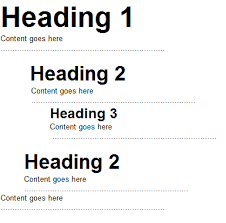When it comes to search engine optimization (SEO), the structure you adopt for an article will play a 
One way to structure an article online is through using different headings through the content. However, how you should use the headings is a question that I am sure many people have asked themselves, with very few getting solid answers. Hopefully from my experiences I shall be able to shed some light on this topic.
The problem I first had with headings is adopting an approach to article writing that will get the best SEO possible – considering this is something I would be doing consistently for a long time, it is important to make sure I was structuring content correctly with headings the right way right from the start. With this, here is how you should use headings in content:
- Heading 1 – this is ONLY used on the post title. It has the highest rating of all the content for the post.
Although it is possible to stick a heading 1 in your content, this is a really bad idea. It has the potential to change your content’s contextuality for a topic if the heading 1 in the content is different from the post title. For example, if the article was titled ‘Manchester United Managers of the Past’ and I had used ‘Jose Mourinho Biography’ as a heading 1 in the content too, there is the possibility the content would be on a tug of war between the two headings 1s for Google and other search engines to determine. - Heading 2s are the first headings you should be using throughout your content. Typically it is good to have heading 2s followed by at least 300 words. Heading 2s have the most weighting of all the headers after the post title/heading 1.
- Heading 3s are useful when you have multiple topics to talk about under heading 2s, so can be used more sparingly if needed.
- Although it is possible to use heading 4s in content, it would make the content quite visually confusing having three levels of headings in the content. Therefore, I personally wouldn’t recommend using heading 4s in your content.
Ultimately, the weighting of SEO importance of headings decreases as the number next to the heading increases. Heading 1 should explain your whole post. Heading 2 should relate to a specific topic of heading 1 and heading 3 the same for heading 2. If you can consistently do this with your content, then you will be onto a SEO winner.




